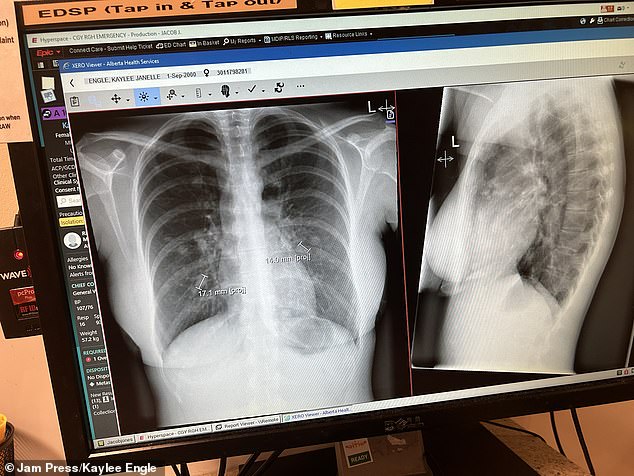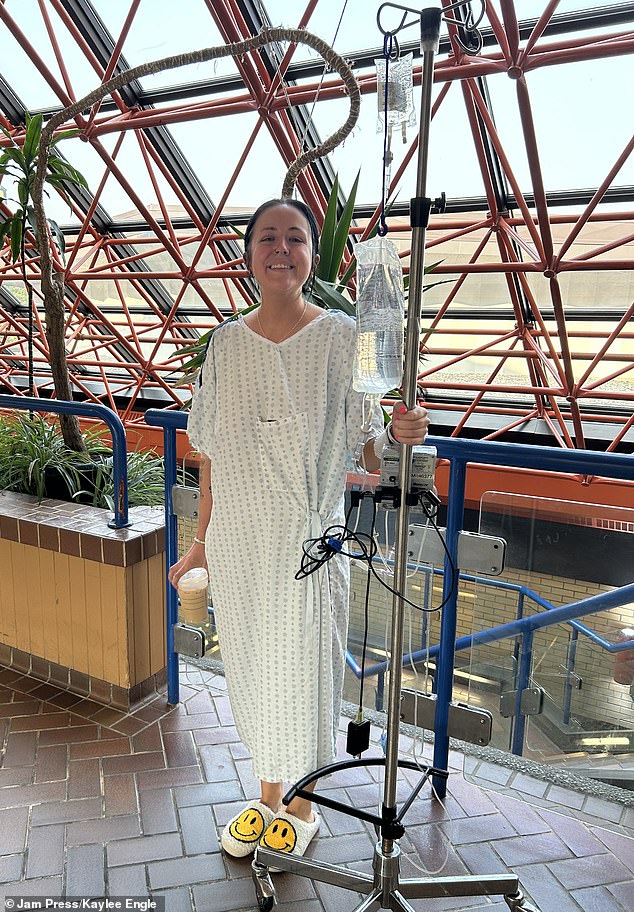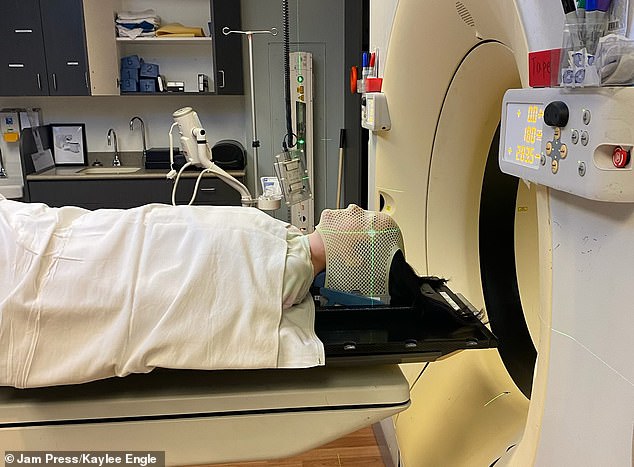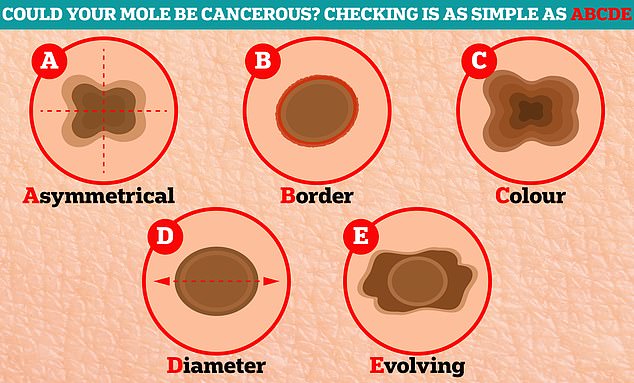- FURTHER READING: Sunscreen Alert as Skin Cancer Cases Poised for Record High
When twenty-two-year-old Kaylee Engle received the news, she collapsed onto the floor of the hospital corridor.
She had just learned that her body was riddled with melanoma skin cancer that had spread to other parts of her body.
The individual from Canada had seven brain tumors and at least 18 in her liver. and at least 20 In each lung, along with two near her heart, and also tumors in her spine, lymph nodes, and adrenal glands.
'It’s incredibly common – you can find it anywhere,' the nanny based in Toronto remarked.
In July 2023, she discovered a solitary lump near her right breast and dismissed it as merely a cyst.
It appeared more akin to an ingrown hair or a pus-filled bump beneath the skin.
However, when Engle kept discovering new bumps appearing in various spots, she realized that something was not quite right.
Following an X-ray, doctors found that she had tiny tumors scattered throughout her body because cancerous skin cells had circulated through her bloodstream and affected other organs.
Reflecting now, the other symptoms she dismissed as minor were evidently connected: unexplained weight gain, feeling nauseous, persistent vomiting, and extreme tiredness.

Initially, the physicians at the urgent care center thought the bumps were fairly harmless cysts as well.
However, X-rays confirmed the direst outcome: the melanoma had infiltrated her lungs, bones, and brain.
The likelihood of succumbing to cancer dramatically increases when it has metastasized to other areas of the body.
Only one out of every five individuals diagnosed with stage 4 melanoma survive for five years following their diagnosis.
However, not only has Engle remained here for two more years, but her cancer has also become stable and is no longer progressing.
Engle started receiving both chemotherapy and immunotherapy shortly after being diagnosed in June 2023.
“Even though my diagnosis is at stage four and has spread nearly everywhere, it doesn’t necessarily make it ‘terminal,’” she stated.
In 2025, nearly two years after receiving my stage four diagnosis, I find myself faced with numerous treatment options, offering greater hope for extending my lifespan.


As of May 2025, she has received 18 rounds of an immunotherapy drug called Nivolumab.
Engle initiated combination immunotherapy but discontinued it after two doses because of autoimmune hepatitis, a situation wherein the immune system assaults the liver, leading to inflammation and possible harm.
Following recovery from her hepatitis, Engle underwent radiation therapy for tumors in her brain and eyes, then proceeded with a course of nivolumab solo.
However, she will have an ongoing battle throughout her entire life kind of situation.
'It’s possible that I might require treatment for the remainder of my life, but there have been instances of individuals achieving NED status,' she mentioned additionally.
Before receiving her shocking diagnosis, Engle was a fit and youthful woman.
Doctors had, over the years, removed several benign moles out of an abundance of caution.
Clusters of normally functioning pigment-producing cells form moles. However, when these cells experience DNA damage—frequently due to extensive exposure to ultraviolet light—it can lead to the development of skin cancer.


Cancer cells can then break away from the original tumor and enter the lymphatic system, a network of vessels throughout the body, and the bloodstream, where they can multiply and form more tumors, which were the lumps all over Engle’s body.
"When I finally got my diagnosis, I was already certain that I had cancer, yet learning the truth still came as a surprise," she stated.
'However, it was reassuring to know that I recognized there was an issue with my health.'
She encountered a challenging journey in searching for the cancer treatment that was effective for her, which also included dealing with an episode of autoimmune hepatitis.
'I was with my girlfriend shopping when I received a call from my oncologist stating that my liver ALT levels were extremely elevated – typically these should be below 50, but mine had soared to 500.'
'They told me I had to head to the hospital right away for intravenous steroid treatments, which I received daily for about a week to lower the levels before I could resume my therapy.'
In October 2024, she had to pause her treatment once more due to respiratory issues.


Considering the presence of 20 tumors in each lung and the immunotherapy medication she was receiving, physicians initially suspected it might be pneumonitis, which refers to inflammation of her lung tissue.
Fortunately, this wasn’t the case, and medical professionals determined that the medications keeping her alive weren’t to blame. Instead, it was probably due to the cancerous growths in her lungs.
However, she was put on the steroid prednisone for several months, known for its various side effects such as causing agitation, 'moon face,' and bloating throughout the body.
Toronto serves as a center for medical advancements, providing Engle with the opportunity to utilize the latest therapeutic options.
She will soon undergo a blood test that will screen for specific indications like tumor mutations or immune markers, which will determine whether she is suitable for Tumor-Infiltrating Lymphocyte therapy (TIL).
It uses her own immune cells found within her tumors, which are extracted and taken to a lab where scientists isolate a mix of immune cells – mostly T cells – that had infiltrated the tumors but were overtaken by the cancer.
Next, the scientists increase their numbers rapidly and transfer them into bioreactors that supply essential nutrients and growth factors, resulting in a battalion of immune cells that are reintroduced into Engle’s body.
She stated: '[It] hasn't been approved in Canada yet, but the U.S. pharmaceutical company has consented to allow me to receive compassionate treatment here prior to its approval for trials in Canada, which will be managed by my oncologist.'

'My oncologist believes this might be a fantastic choice, and I should probably be able to resume my immunotherapy if necessary afterward!'
Her future remains uncertain.
Progress in immunotherapy and precision medicine has surged over the last ten years, showing encouraging signs that these treatments can reduce tumor size, prolong life expectancy, and even lead to sustained remission for certain advanced cancers.
“I am willing to attempt everything to lead a complete life,” she stated.
But I’m making the most out of each day and am quite hopeful about what’s ahead, regardless of whether it involves continuous treatment or achieving full remission, my ultimate aim—something I believe I will accomplish down the line.
An itchy, painful, or sensitive mole shouldn’t be dismissed. Moreover, moles that bleed, cause discomfort, or begin to discharge liquid are concerning symptoms.
Important indicators of a possibly cancerous mole encompass quick enlargement, variations in hue, and an uneven border.
If a mole rapidly increases in size over several weeks, exhibits various hues (like shades of brown, black, red, white, or blue) in an inconsistent manner, or loses symmetry, it should be examined by a medical professional. These alterations might suggest the presence of skin cancer.

Thirty percent of melanoma instances originate in moles; however, there is a minor fraction of cases that cannot be attributed to any specific location.
According to the American Cancer Society, approximately 105,000 new cases of melanoma are expected to be identified in 2024, with about four percent being at stage four.
Each year, melanoma leads to over 8,300 deaths among Americans, as stated by the Melanoma Research Foundation (MRF). However, approximately 90% of these cases could potentially be avoided with careful attention to protecting oneself from the sun.
Typically, the average age at which diagnosis occurs is 63 years.
Nevertheless, melanoma stands as one of the most prevalent forms of cancer among individuals under 30 years old, with a significant increase observed over the last thirty years, as reported by the Cleveland Clinic.
Read more


%20(1024%20x%201024%20piksel)%20(5).png)
%20(1024%20x%201024%20piksel)%20(1).png)
0 Comments